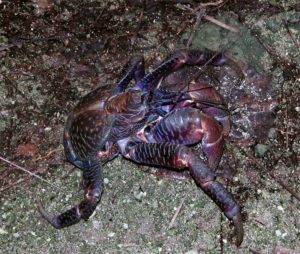Published in the Ocean Watch column, Honolulu Star-Advertiser © Susan Scott
April 22, 2005

This week while going through my papers, I discovered that while I was in Palmyra, I wrote almost nothing about coconut crabs. That’s like going to Churchill in Canada’s Manitoba and not mentioning the polar bears.
Like those big white bears, traveling to see these big colorful crabs is well-worth the trip. Once you get to know a coconut crab, you’ll never again ask how they taste, because killing one is of the question.
Not everyone agrees. Coconut crabs are scarce in their South Pacific island homes, because people have over-hunted them.Still, there’s international bickering over whether these crabs are, or are not, an endangered species.
These creatures, however, are easy to catch, taste good, live only on tropical islands, and don’t reach sexual maturity until they’re eight years old. It’s not rocket science.
Before I went to Palmyra, where these crabs are considered endangered, and therefore, are passionately protected, I didn’t appreciate their beauty.Some are several shades of one color, such as blue, red, orange or brown; others bear a stunning combination.
Young coconut crabs are fast runners, but the big ones (10 to 20 pounds) stand their ground when confronted by a human. Then, the crab raises one of its long, narrow legs straight up, as if saying “Stand back!” If you move, it thrusts the pointed leg forward, like a sword.
The behavior always made us smile. These creatures are Davids to the world’s Goliaths.
When threatened, adult coconut crabs always face you, making obvious their two enormous front claws. One claw cuts, the other grips. Either can take off a finger.
These formidable appendages are excellent for opening green coconuts, a tough task for most people, even with tools.
Contrary to popular belief, coconut crabs don’t climb trees to get coconuts.They eat the ones on the ground, plus whatever else they come across, such as fruit, seeds or dead animals.
Another name for the coconut crab is robber crab, because if they’re attracted to something, they sometimes take it. My friend Alex filmed a coconut crab dragging a machete down a path. The knife had been used for cutting coconuts and apparently, it smelled too good to resist.
Coconut crabs arrive on islands from the sea. The female drops her fertilized eggs into the ocean where they hatch and eventually develop into little crabs. These crawl ashore, and true to their hermit crab heritage, find a shell to protect their backsides.
After they outgrow these snail suits though, they go naked. For the rest of their lives, they keep their soft abdomens flexed beneath them.
Coconut crabs have been documented to live as long as 70 years. Some biologists believe they may live to 100.
So here’s a marine invertebrate that lives on land for a century, comes in brilliant colors, has swords for legs and vice-grips and switchblades for claws, is brave as Godzilla and steals, well, whatever it wants. To know one is to love one.